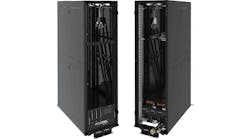Just Wait: The AI Boom Will Supersize Hyperscale Data Center Capacity
Synergy Research Group is predicting that hyperscale data center capacity, driven by AI workloads, will nearly triple in the next six years.
According to the firm's latest forecast data, the average capacity of hyperscale data centers to come online over that timespan will soon be over double that of currently operational hyperscale data centers.
Synergy's hyperscale research is based on an analysis of the data center footprint and operations of 19 of the world’s major cloud and internet service firms, who meet the analyst's criteria for being considered hyperscale operators.
"While the trend has always been for the critical IT load of hyperscale data centers to grow in size over time, the impact of generative AI technology and services has provided an added impetus to the need for substantially more powerful facilities," observes Synergy Research.
The analyst reasons that, as the average IT load of individual data centers ramps up, the number of operational hyperscale data centers will also continue to grow apace. Some degree of retrofitting to existing data centers to boost their capacity will also come into play.
The overall result, according to Synergy's latest data, is that the total capacity of all operational hyperscale data centers will grow almost threefold in the next six years.
The scope of the forecast includes the largest hyperscale operators in SaaS, IaaS, PaaS, search, social networking, e-commerce and gaming. According to Synergy Research, by mid-2023, those companies had 926 major data centers in operation around the world.
Synergy's known pipeline of future data centers includes a further 427 facilities, accounting for one of the main inputs to the forecast model.
Notably, according to the analyst, "the mix of hyperscale data centers continues to change, region by region, and owned versus leased, but in aggregate the total number of worldwide data centers has doubled in the last five years."
Synergy's research summary further observes that the impact of recent generative AI technology advances "is not so much to increase the number of data centers - which will continue to grow by well over a hundred per year - but to substantially increase the amount of power required to run those data centers."
The challenge as commonly understood is that, as the number of GPUs in hyperscale data centers increases exponentially, driven primarily by AI workloads, so the power density of associated racks and data center facilities will also need to increase substantially.
"This is causing hyperscale operators to rethink some of their data center architecture and deployment plans," contends Synergy Research.
AI a Moving Target for Cloud Providers?
For its part, Dell'Oro Group in September released data suggesting that current AI investments have not yet been enough to offset what the analyst characterizes as the "hyperscale digestion cycle" for some cloud service providers, leading to a dip in cloud capex of 2% in 2Q of 2023.
“Despite recent heightened investments towards AI infrastructure, hyperscale cloud capex has been decelerating as some of the major cloud service providers are overdue for a capex digestion cycle and have been optimizing their spending on general-purpose infrastructure,” said Baron Fung, Sr. Research Director at Dell’Oro Group.
The latest research from Dell'Oro notes that despite the slight deflation in cloud spending, Microsoft and Google will remain in a capex expansion cycle, experiencing double-digit growth in 2023 from both greenfield investments and refresh.
Fung observed that, as enterprise IT spending remains depressed, revenues for the server and storage OEMs have now trended negatively in double-digits year-over-year for two consecutive quarters.
"We anticipate demand to gradually improve heading into 2024, driven by the introduction of a new server platform refresh from Intel and AMD, as well as a shift towards accelerated computing for AI/ML applications,” he added.
Despite server and storage systems revenue being forecast for a 2% decline in 2023, network and physical infrastructure maintains double-digit revenue growth, according to the research.
Dell'Oro's 2Q 2023 Data Center IT Capex Quarterly Report further noted that Dell led all OEMs in server revenue in 2Q 2023, followed by HPE and IEI Systems (the former Inspur).
Meanwhile, also in the second quarter, Dell'Oro stated that white box server vendors gained 6 points of YoY revenue share over OEMs.
Dell'Oro's data reckons that the top 4 US cloud service providers, identified as Amazon, Google, Meta, and Microsoft, are on track to launch services in 25 new regions in 2023 -- "mostly from Microsoft."
For additional insight on this very topic, see Business Insider's recent and briskly told omnibus article describing how "data centers are sprouting up as a result of the AI boom, minting fortunes, sucking up energy, and changing rural America."
Keep pace with the fast-moving world of data centers and cloud computing by connecting with Data Center Frontier on LinkedIn, following us on X/Twitter and Facebook, and signing up for our weekly newsletters using the form below.

Matt Vincent
A B2B technology journalist and editor with more than two decades of experience, Matt Vincent is Editor in Chief of Data Center Frontier.





